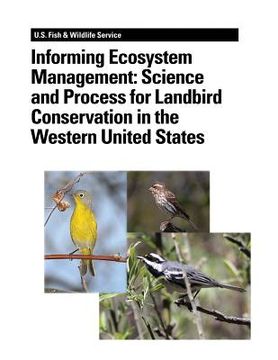Informing Ecosystem Management: Science and Process for Landbird Conservation in the Western United States (en Inglés)
Reseña del libro "Informing Ecosystem Management: Science and Process for Landbird Conservation in the Western United States (en Inglés)"
Recent advances in bird conservation are marked by the integration of science and land management. Information gained from past research can now be used to develop user-friendly management tools. Partners in Flight (Rich et al. 2004) as well as shorebirds (Brown et al. 2001), waterbirds (Kushlan et al. 2002), and especially waterfowl (North American Waterfowl Management Plan Committee 2004) initiatives use their respective conservation plans to catalyze this process and influence land management planning across the landscape. Using these conservation plans within a broader monitoring framework, managers can glean pertinent information about ecosystem dynamics. Land managers work in a setting where change is continuous and unpredictable (Bosch et al. 2003). Within this dynamic environment, they often are faced with making management decisions without any scientific support to guide them. Management activities need to be linked to the scientific process in order to better understand potential influences on the surrounding ecosystem. One scientific tool that will help to forge this link is monitoring. Monitoring measures population and habitat change and often elucidates the causes of change. Performed in concert with management actions, monitoring can help to evaluate the effectiveness of management prescriptions (Alexander et al. 2007) and provide assurance that management efforts are focusing on agreed-upon goals (Keough and Blahna 2006). Land managers and biologists commonly monitor birds, both to track bird populations themselves, and as a tool to measure ecosystem health as a whole. Birds are relatively easy and cost-effective to monitor and standardized methodologies exist to allow comparisons across sites (Ralph et al. 1993). Birds occupy a wide diversity of ecological niches and respond quickly to changes in their environment. While bird monitoring is common, it is not always clear exactly what is gained by this monitoring. Primarily, bird monitoring is integral in answering the immediate questions about the effects of land management on an ecosystem. In addition, the value of monitoring data could increase with time as it contributes to answering longer and larger scale questions. However, monitoring data are only as valuable as the extent to which they are applied. It is therefore important that we step back and evaluate the influence that bird monitoring projects have had on management. With this, we can learn from the past and inform others of how to implement successful, meaningful monitoring projects for the future. This volume highlights bird conservation successes resulting from the integration of science, management, and learning within a collaborative framework, i.e., adaptive management (Jacobson et al. 2006). The adaptive management process consists of six stages: assessment, design, implementation, monitoring, evaluation, and adjustment. Land management projects are implemented one stage at a time and tested at each step, allowing for detection and correction of any deleterious effects (Moir and Block 2001). Ideally, information from one stage is incorporated into subsequent stages and an informational feedback loop or "adaptive management circle" is created. When properly integrated, the process is continuous, cyclic, and constantly evolving (Haney and Power 1996). In this publication, we present ten examples illustrating both the process and science behind bird conservation throughout the western United States. We begin with a series of papers that describe integrating bird conservation and effectiveness monitoring into land management guidelines and emphasize the importance of partnerships. This is followed by a series of case studies which highlight bird monitoring within the adaptive management framework. We emphasize the science of monitoring and the process of its integration into land management because both are necessary in order for effectiveness monitoring to fully impact decision making.

